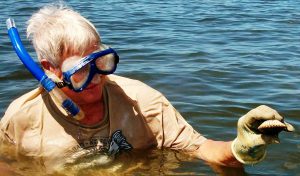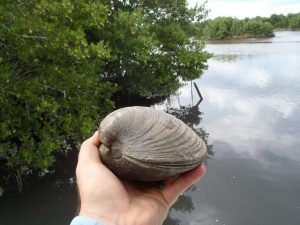Bivalves are mollusks that have a two-part hinged shell which hides the soft-bodied animal inside. Clams, oysters, scallops and mussels are all considered bivalves. Let’s take a closer look at a couple.
Bay Scallop

Bay scallops (Argopecten irradians) occur throughout Florida’s Gulf Coast and north to West Palm Beach on the Atlantic Coast. An adult bay scallop shell can reach up to three inches across. In the water, they are recognized by the many tiny blue eyes that line the rim of each shell. These eyes detect movement. When threatened, a scallop will swim away by quickly and repeatedly closing its shell, expelling the water inside, which propels the scallop through the water.
Scallops open their shells when feeding or breathing and close them when predators approach. Bay scallops feed by filtering particles from the water. They accomplish this by funneling water across two pathways called siphons. One pathway takes the water in where the particles are skimmed off, and then the second pathway expels the remaining filtered water. A single adult scallop can pump as much as 15.5 quarts of water per hour.
In Southwest Florida, bay scallops are a protected species because there are so few, but historically this area supported a healthy population. Perhaps someday we’ll see greater numbers again here.
Hard Clam

Two species of hard clams live in Florida: The northern hard clam (Mercenaria mercenaria) and the southern hard clam (M. campechiensis). Here in Southwest Florida, the southern hard clam is our native species — but the northern hard clam is grown for shellfish aquaculture, due to its longer shelf life. Both clams have gray or whitish exterior shells. The interior of the shell is usually white, but sometimes the northern clam has purple along the outer edges. The southern clam typically has larger, thicker shells.
Clams may live 20 years or more, in contrast to the scallop, which has a life span of only 12 to 18 months. Clams have no eyes, but they respond to touch and vibrations. Like bay scallops, they have two siphons for feeding. Clams extend or retract their siphons in response to threats from predators or to changes in water quality. Unlike scallops, clams cannot swim and so instead they burrow into sand or mud. They do this using their muscular foot.
Shellfish Harvesting
Because both clams and scallops are filter feeders, they absorb and concentrate whatever pollutants are present, making them good indicators of the overall health of a body of water. Harvest of clams (and some other shellfish) in Florida is closely regulated by the state to ensure public safety. Shellfish can only be harvested from designated areas. These areas may periodically close to harvesting based on pollution events, such as rainfall or increased river flow, or when harmful algae are present.
Shellfish harvesting maps and daily open and closure status are available online. Recreational harvest of any shellfish also requires a Florida saltwater fishing license.
Monitoring populations
Each year, volunteers take to the waters of Lemon Bay and Gasparilla Sound to monitor the health and status of these two important bivalves. This year’s Great Bay Scallop and Hard Clam Search will be held Aug. 10. This one-day event uses citizen scientists to conduct a snapshot survey using standardized methods.
The Great Bay Scallop and Hard Clam Search complements similar searches in Southwest Florida. Having standardized methods allows researchers to compare data collected from year to year, site to site, and bay to bay. This is fun family event, so even junior naturalists are welcome to participate (with a parent or guardian, of course). For more information about the Search visit: https://2019greatbayscallopandhardclamsearch.eventbrite.com.
 1
1
